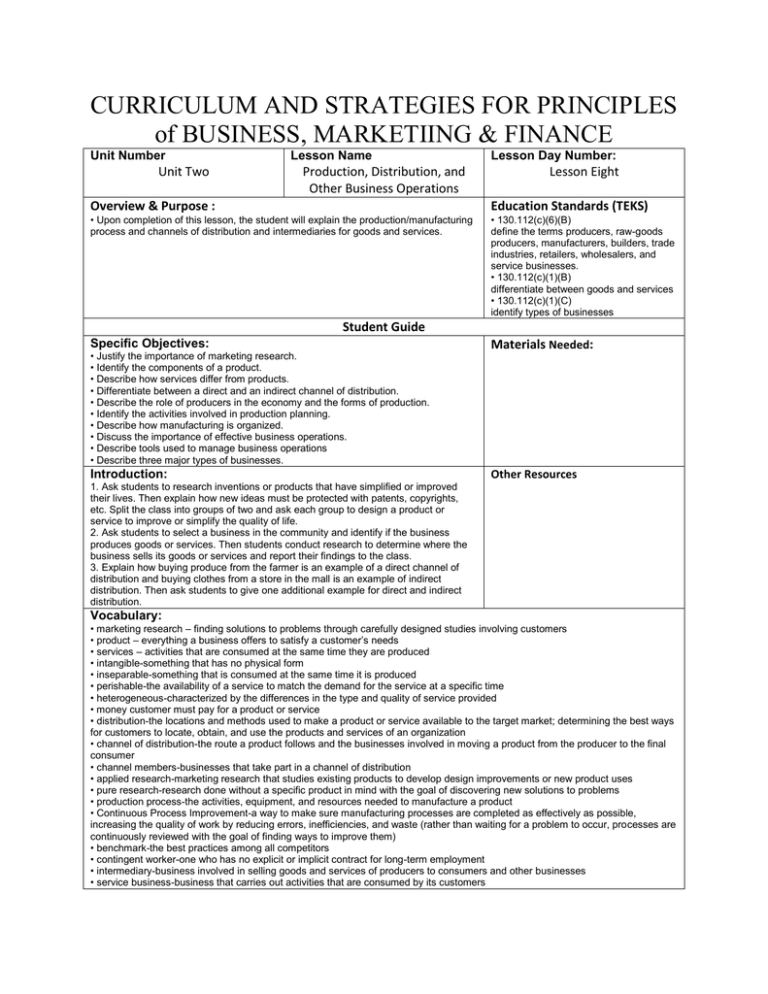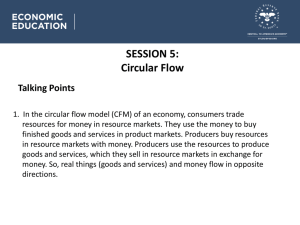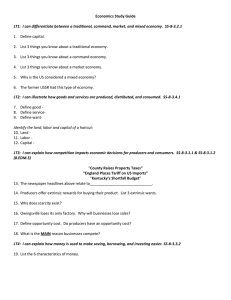Specific Objectives
advertisement

CURRICULUM AND STRATEGIES FOR PRINCIPLES of BUSINESS, MARKETIING & FINANCE Unit Number Unit Two Lesson Name Production, Distribution, and Other Business Operations Lesson Day Number: Lesson Eight Overview & Purpose : Education Standards (TEKS) • Upon completion of this lesson, the student will explain the production/manufacturing process and channels of distribution and intermediaries for goods and services. • 130.112(c)(6)(B) define the terms producers, raw-goods producers, manufacturers, builders, trade industries, retailers, wholesalers, and service businesses. • 130.112(c)(1)(B) differentiate between goods and services • 130.112(c)(1)(C) identify types of businesses Student Guide Specific Objectives: • Justify the importance of marketing research. • Identify the components of a product. • Describe how services differ from products. • Differentiate between a direct and an indirect channel of distribution. • Describe the role of producers in the economy and the forms of production. • Identify the activities involved in production planning. • Describe how manufacturing is organized. • Discuss the importance of effective business operations. • Describe tools used to manage business operations • Describe three major types of businesses. Introduction: Materials Needed: Other Resources 1. Ask students to research inventions or products that have simplified or improved their lives. Then explain how new ideas must be protected with patents, copyrights, etc. Split the class into groups of two and ask each group to design a product or service to improve or simplify the quality of life. 2. Ask students to select a business in the community and identify if the business produces goods or services. Then students conduct research to determine where the business sells its goods or services and report their findings to the class. 3. Explain how buying produce from the farmer is an example of a direct channel of distribution and buying clothes from a store in the mall is an example of indirect distribution. Then ask students to give one additional example for direct and indirect distribution. Vocabulary: • marketing research – finding solutions to problems through carefully designed studies involving customers • product – everything a business offers to satisfy a customer’s needs • services – activities that are consumed at the same time they are produced • intangible-something that has no physical form • inseparable-something that is consumed at the same time it is produced • perishable-the availability of a service to match the demand for the service at a specific time • heterogeneous-characterized by the differences in the type and quality of service provided • money customer must pay for a product or service • distribution-the locations and methods used to make a product or service available to the target market; determining the best ways for customers to locate, obtain, and use the products and services of an organization • channel of distribution-the route a product follows and the businesses involved in moving a product from the producer to the final consumer • channel members-businesses that take part in a channel of distribution • applied research-marketing research that studies existing products to develop design improvements or new product uses • pure research-research done without a specific product in mind with the goal of discovering new solutions to problems • production process-the activities, equipment, and resources needed to manufacture a product • Continuous Process Improvement-a way to make sure manufacturing processes are completed as effectively as possible, increasing the quality of work by reducing errors, inefficiencies, and waste (rather than waiting for a problem to occur, processes are continuously reviewed with the goal of finding ways to improve them) • benchmark-the best practices among all competitors • contingent worker-one who has no explicit or implicit contract for long-term employment • intermediary-business involved in selling goods and services of producers to consumers and other businesses • service business-business that carries out activities that are consumed by its customers Outline: I. Production Activities A. Product Development 1. Product research a. applied research-studies existing products to develop design improvements or new product uses b. pure research-research done without a specific product in mind with the goal of discovering new solutions to problems 2. Product design-new product idea is developed into a product to sell profitably 3. Production planning (production process) a. production resources-machines, tools, other equipment b. personnel-employees and necessary skills B. Inventory Management 1. inventory-detailed account of a company’s materials, supplies, and finished products 2. inventory management-maintains the supply of all resources needed for production and the products produced C. Manufacturing Procedures 1. organizing the work area by type of process or assembly required 2. improving manufacturing a. need for faster production b. need for increased quality c. need for reduced costs D. Continuous Process Improvement (CPI) 1. increases the quality of work by reducing errors, inefficiencies, and waste 2. achieve goals by improving the quality of work 3. benchmarks-best practices among all competitors II. Importance of Business Operations A. Day-to-Day Operations-determine the success or failure of a business B. Types of Business Operations 1. facilities management-buildings, building maintenance, energy and environmental management 2. logistics-managing the acquisition, movement and storage of supplies, materials, and finished products in a business (supply chain management) 3. just-in-time—goods arrive when needed (just in time) for production, use or sale rather than sitting in storage 4. scheduling-determining the activities that need to be completed, the people who will complete the work, and resources needed for the task 5. safety and security-protecting people and property from damage, injury due to crime, unintentional actions or natural causes such as tornados, hurricanes, and earthquakes 6. information management a. collect, organize, and securely maintain all needed information b. provide instantaneous access to information required to perform work and make decisions c. prevent access to information by those unauthorized to use it d. use technology to improve communication and information sharing V. Types of Businesses A. Producers-create the products and services used by individuals and other businesses 1. Extractors-a business that takes resources from nature for direct consumption or for use in developing other products (pump oil, mine coal, or cut timber) 2. Manufacturers-get supplies from other producers and convert them into products B. Intermediaries-businesses involved in selling the goods and services of producers to consumers and other businesses C. Service Business-carries out activities that are consumed by its customers D. contingent worker-one who has no explicit or implicit contract for long-term employment VI. Product Planning A. Product-everything a business offers to satisfy a customer’s needs 1. basic product-simplest form of a product 2. product features-additions and improvements to the basic product 3. options-when customers are offered choices of features 4. brand name-provides a unique identification for a company’s products 5. packaging-provides protection and security for the product before it is used 6. guarantee or warranty-a way to build customer confidence in a company’s Ask students to give examples of “new” and “improved” products. Then explain how applied research helped determine the product changes. Ask students to briefly write about a new product that they expect to be a big hit. Then conduct class discussion about the ideas. The U.S. has steadily changed from a production to a service society. Ask students which parts of the country have been hit hard by this transition. Then ask students how manufacturing could be revived in the U.S. Farmers produce a record corn crop and there are not enough grain storage areas for the crop. Explain how an increase in production also affects required facilities. This situation results in farmers leaving their crop in the field until elevator space becomes available. Leaving the crop in the field during the winter results in the risk of lost product with harsh weather conditions. Ask students to give examples of safety features to protect individuals in a business. A business plan is essential for success. The business operations plan is the necessary road map for success. Technology has allowed key individuals involved in the business operation process to communicate from different locations. Essential communication has been made easier with the latest technology. Ask students to list examples of actual businesses for the following categories: extractors, manufacturers, intermediaries, and service business. Explain how contingent workers have become increasing popular in a dynamic world. Then explain how businesses save money by hiring contingent workers who do not require fringe benefits. Fast food restaurants frequently test market new products in different geographic regions before making decisions to implement new products nationwide. Brand names carry customer expectations. Ask students to give examples of limited production items and test marketing. products B. Product Planning Procedures-costly and time-consuming 1. Idea development 2. Idea screening 3. Strategy development 4. Production and financial planning 5. Limited production and test marketing 6. Full-scale production Looking Forward: Review (LSI Quadrants I and IV): Q: What is manufacturing? A: Manufacturing combines raw materials and processed goods into finished products. Q: What is materials processing? A: Materials processing involves changing the form of raw materials so they can be consumed or used to make other products (example: refining crude oil to form gasoline and other petroleum products). Q: How is applied research different than pure research? A: Applied research is conducted for existing products and pure research is conducted for possible new products. Q: What is an operational plan? A: The operation plan identifies how work will be done, who will do it, and what resources will be needed. Q: What is meant by services being inseparable? A: Services are consumed at the same time they are produced. Q: Why do companies encourage idea screening? A: Idea screening develops a large number of product ideas and more possible selections. Q: How are services different than products? A: Services are intangible and products are tangible. Q: Why have manufacturers implemented Continuous Process Improvement (CPI)? A: CPI increases the quality of work by reducing errors, inefficiencies, and waste. ATTRACTING BUSINESS TO THE COMMUNITY Ask student to propose a good manufacturing plant for their community. Students must list the operational needs for the plant and explain the community resources to meet the needs. Prepare a convincing PowerPoint presentation.





